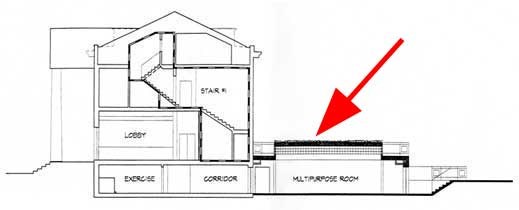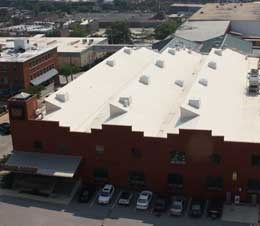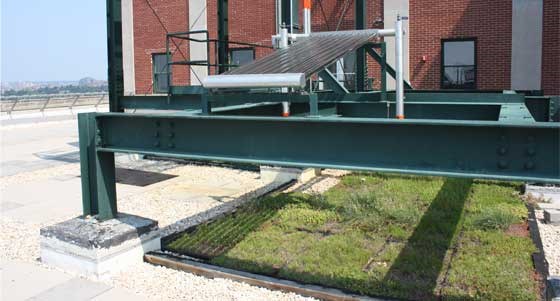Last updated: March 31, 2022
Article
Green Roofs on Historic Buildings: Green Roof Alternatives

Ground Level Green Roofs
A green roof does not have to be high above ground to be beneficial. Modular and integrated, extensive and intensive green roofing systems can be installed at ground level in a courtyard or as part of a terrace above an underground parking garage or other structure. A ground level green roof does not appear as a traditional green roof, but rather as a site feature continuous with the existing landscape.
Brown Roofs
Brown roofs, also known as biodiverse green roofs are a type of vegetated roof system designed specifically to provide a biologically diverse habitat for plants, animals, and insects that formerly thrived on derelict and disused industrial or commercial land. Brown roofs are installed in essentially the same way as green roofs but their growing medium is composed of recycled building materials, soil, and spoil from the site. Materials such as concrete slabs or local brush may be used to create a habitat for displaced flora and fauna. These roofs are often left to be colonized naturally by native plants and species.

Cool Roofs
A cool roof is an alternative “green” roofing treatment that can also be used on historic buildings with flat roofs as well as on some with roofs that are too steeply sloped for plant material. A cool roof has roofing material with a high reflectance to reflect heat. Cool roofs are measured by their solar reflectance (fraction of solar energy that is reflected by the roof) and the thermal emittance (the ability of the roof surface to radiate absorbed heat). The Solar Reflectance Index (SRI) is the combination of these two values and it ranges from 0 to 100. A standard black surface has an SRI value of 0 and a standard white surface has an SRI value of 100. The higher the SRI, the cooler the roofing surface. To help mitigate the heat island effect a low–sloped roof (2:12 or less) should have a minimum initial SRI of 78. A steep–sloped roof (greater than 2:12) should have a minimum initial SRI of 29.
A roof with a high SRI does not transfer as much heat to the building or emit it into the air or buildings close by. Cool roofs have similar benefits to green roofs in that they reduce internal building temperatures, increase occupant comfort, decrease cooling loads, lower energy bills, and increase the life expectancy of the roof. However, not all climates are well suited for cool roofs; they are most effective in cooling–dominated climates—areas that have hot summer months which require the use of mechanical air–conditioning. In colder climates, a high reflectance roof would rob the building of the solar heat gain that is desirable in the winter months. The summer benefits should be weighed against winter losses to determine if a cool roof is appropriate.
Before installing a cool roof, it is important to keep in mind that reflection of solar rays off of cool roofs can adversely affect neighboring buildings and their tenants. When a cool roof is installed on a low roof it reflects light upward toward taller buildings, which may necessitate the installation of shades or other devices. Intense reflection can also cause rooftop equipment to overheat or masonry control joints to expand beyond normal limits. Alternatively, light reflecting off of a cool roof into another building can have a positive effect by increasing daylighting in the interior when done in such a way that does not increase glare. As always, the benefits must be weighed against any negative effects.
A cool roof that is a light color and highly visible may not be compatible with the character of a historic building. Thus, as with green roofs, flat roofs are the best candidates for cool roofs on historic buildings because they are usually not visible. Roofs that are not flat should be evaluated to determine if changes in the material and color of a cool roof would negatively affect the building’s historic character. Cool roof products are available in a wider range of colors beyond white and in more traditional materials, such as shingles or standing seam metal, which may be more appropriate for historic buildings.

Combining Green Roofs, Cool Roofs, and Solar Installations
A green roof can also be supplemented with other sustainable features, such as a cool roof or solar panels. Combining a green roof and solar panels may actually benefit both installations. Lower roof temperatures that result from a green roof help to boost the efficiency of solar panels, which operate less efficiently at extreme temperatures. Mounted solar panels can sometimes protect vegetation by sheltering it from gusting winds and shading it to keep plants from dehydrating in intensive heat or periods of drought. Cool roofs and green roofs are easily combined, especially when cool roofs are placed in areas where a green roof would be too visible, such as near a roof edge.
